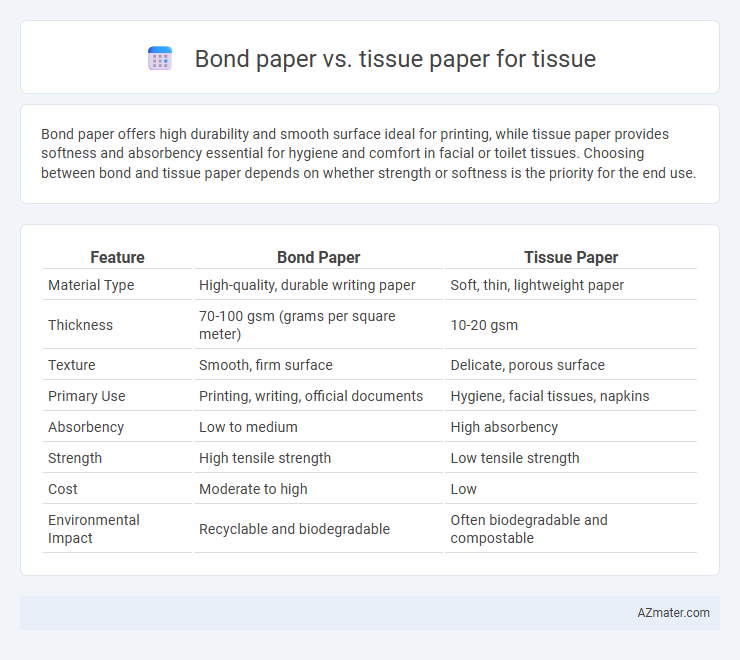Bond paper offers high durability and smooth surface ideal for printing, while tissue paper provides softness and absorbency essential for hygiene and comfort in facial or toilet tissues. Choosing between bond and tissue paper depends on whether strength or softness is the priority for the end use.
Table of Comparison
| Feature | Bond Paper | Tissue Paper |
|---|---|---|
| Material Type | High-quality, durable writing paper | Soft, thin, lightweight paper |
| Thickness | 70-100 gsm (grams per square meter) | 10-20 gsm |
| Texture | Smooth, firm surface | Delicate, porous surface |
| Primary Use | Printing, writing, official documents | Hygiene, facial tissues, napkins |
| Absorbency | Low to medium | High absorbency |
| Strength | High tensile strength | Low tensile strength |
| Cost | Moderate to high | Low |
| Environmental Impact | Recyclable and biodegradable | Often biodegradable and compostable |
Introduction to Bond Paper and Tissue Paper
Bond paper is a durable, high-quality writing paper commonly used for office documents, letterheads, and stationery due to its smooth texture and strength. Tissue paper is lightweight, thin, and highly absorbent, designed primarily for hygiene purposes such as facial tissues, napkins, and wrapping delicate items. The key difference lies in bond paper's rigidity and opacity versus tissue paper's softness and translucency, which cater to distinct functional needs.
Composition and Manufacturing Differences
Bond paper is primarily composed of wood cellulose fibers processed through chemical pulping, resulting in a durable and high-strength sheet ideal for writing and printing applications. Tissue paper consists of shorter cellulose fibers obtained from recycled materials or virgin pulp, manufactured via a wet-pressed process that produces a thin, absorbent, and flexible product suitable for hygiene uses. The manufacturing of bond paper involves calendering for smoothness and uniformity, while tissue paper undergoes creping to enhance softness and elasticity, reflecting their distinct structural and functional properties.
Absorbency: Bond Paper vs Tissue Paper
Tissue paper exhibits superior absorbency compared to bond paper due to its porous and fibrous structure designed specifically for liquid retention. Bond paper, typically used for printing and writing, has a denser composition that limits its capacity to absorb moisture efficiently. The high absorbency of tissue paper makes it ideal for hygiene products, while bond paper's low absorbency suits documentation purposes.
Strength and Durability Comparison
Bond paper exhibits significantly higher strength and durability compared to tissue paper, making it ideal for applications requiring resistance to tearing and wear. Its dense fiber composition and sturdy manufacturing process provide superior tensile strength and longevity under stress. In contrast, tissue paper is lightweight and delicate, designed for softness and absorbency rather than durability, resulting in quicker degradation when subjected to repeated handling or moisture exposure.
Common Uses of Bond Paper
Bond paper is commonly used for printing documents, letterheads, and stationery due to its durability and smooth surface, which ensures crisp, clear text and images. Its heavyweight quality makes it ideal for official correspondence, legal documents, and business reports, providing a professional finish. Unlike tissue paper, bond paper is designed for writing and printing applications rather than packaging or hygiene purposes.
Common Applications of Tissue Paper
Tissue paper is commonly used for gift wrapping, cushioning fragile items, and decorative purposes due to its lightweight, soft texture, and translucency, making it ideal for protective packaging and crafts. In contrast, bond paper, known for its durability and smooth finish, is primarily used for printing documents, letters, and office stationery rather than cushioning or wrapping. Tissue paper's absorbent and flexible nature also makes it suitable for hygiene products, floral arrangements, and food packaging, further distinguishing its applications from bond paper.
Cost Analysis: Bond Paper vs Tissue Paper
Bond paper generally incurs higher production costs due to its durability and thickness, making it more expensive than tissue paper, which is produced at lower costs because of its lightweight and less dense fibers. Tissue paper offers cost advantages for bulk packaging and disposable uses, while bond paper's cost justifies its use in documents requiring longevity and a professional appearance. Analyzing unit price and usage volume reveals that tissue paper provides a more economical option for high-volume, low-margin applications compared to bond paper.
Environmental Impact and Sustainability
Bond paper production generally consumes more energy and water compared to tissue paper, resulting in a higher carbon footprint due to its intensive chemical processes and bleaching. Tissue paper, often made from recycled materials and biodegradable fibers, offers greater sustainability by reducing waste and promoting faster decomposition. Choosing tissue paper supports environmentally friendly practices through lower resource consumption and improved recyclability, making it a preferable option for eco-conscious consumers.
Choosing the Right Paper for Tissue Production
Selecting the appropriate paper for tissue production significantly influences product softness, strength, and absorbency. Bond paper, known for its durability and smooth surface, is less ideal for tissue as it lacks the delicate softness and high absorbency required. Tissue paper, engineered specifically for softness, lightweight texture, and rapid liquid absorption, is the preferred choice for manufacturing hygiene and facial tissues.
Conclusion: Which Paper is Better for Tissue?
Bond paper offers superior durability, print quality, and smooth texture, making it ideal for documents requiring longevity. Tissue paper excels in softness, absorbency, and biodegradability, which are crucial for hygiene and comfort applications. For tissues specifically designed for personal care, tissue paper is the better choice due to its gentle texture and sanitary properties.

Infographic: Bond paper vs Tissue paper for Tissue
 azmater.com
azmater.com